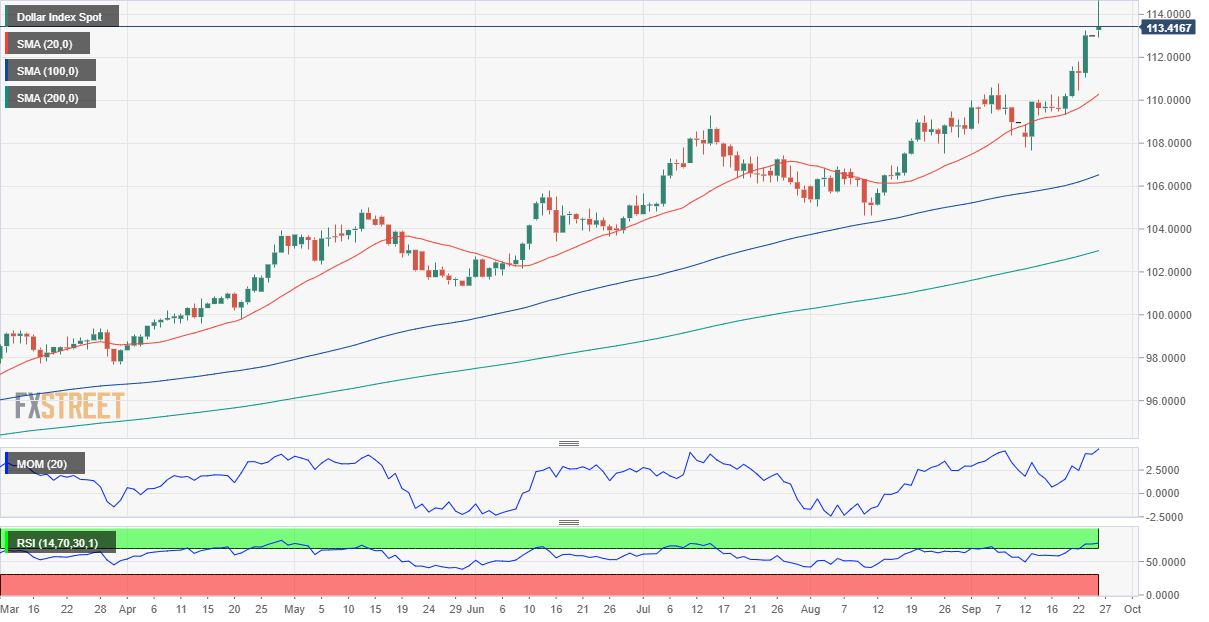- US CB Consumer Confidence is expected to have improved further in September.
- Record high inflation is likely to have taken its toll on households’ sentiment.
- USD bullish case will likely continue regardless of the outcome of the report.
The US Conference Board Consumer Confidence is expected to have improved further in September, foreseen at 104.0 in September after posting 103.2 in August, the index declined between May and July, bottoming at 95.3. The index is usually seen as a leading indicator of consumer spending, a critical measure of the country’s economic health.
In August, the sub-index measuring the Present Situation sub-component improved to 145.4 from 139.7, while the Expectations Index increased to 75.1 from 65.6.
US inflation remains at record highs, potentially undermining household sentiment. According to the Bureau of Labor Statistics, the annual Consumer Price Index hit 8.3% in August, better than the multi-decade high reached in June at 9.1%. However, core inflation jumped to 6.3%, rising from an annual rate of 5.9% previously. Financial markets entered risk-off mode with the release, maintaining the sour tone despite the US Federal Reserve delivering a third consecutive 75 bps rate hike afterward.
What’s going on?
Little did we know that the virus that hit Wuhan at the end of 2019 would be the root of a global recession. The pandemic that spread like wildfire in early 2020 resulted in the worst economic setback in decades. The initial lockdowns meant to prevent contagions halted global trade. And putting the machine back to work has been tougher than anticipated. Supply chain issues and bottlenecks sent prices up, but at the time markets were coming to balance, Russia decided to start a war with Ukraine.
All of these scenarios caught policymakers and governments off guard. Ultra-loose financial conditions, brought in to deal with the first stages of the coronavirus pandemic, are now being quickly reversed, but massive rate hikes tend to slow economic growth. The United Kingdom was the first economy to acknowledge recession, while US authorities have tended to talk down the idea, despite two consecutive Gross Domestic Product contractions.
What’s coming next?
Last week, US President Joe Biden said that the COVID-19 pandemic was over. But is it? The number of new contagions reached a record high in January this year, and while new cases and deaths have decreased significantly, the WHO does not believe we have left the pandemic behind. On average, there are 400 coronavirus-related daily deaths in the US. Lovers and detractors all face the same challenges with jobs, salaries, and inflation.
The US may be doing better than other major economies. Consumer Confidence may have bounced in September. But at the end of the day, the risk of recession remains high, and inflation seems indifferent to policymakers’ aggressive actions.
More uncertainty and a steeper economic setback is on the cards for this year and the next one and there is little that the authorities can do about it.
USD possible scenarios
Indeed, an upbeat outcome of the Conference Board report could bring temporal relief to financial markets, but such optimism should not last long. Anyway, it could help Wall Street recover, with a better market mood, probably resulting in a USD decline.
A worse-than-anticipated result could end up fueling the greenback by spurring additional risk aversion.
The DXY hit a record high of 114.67 on Monday, trimming intraday gains but still bullish according to the daily chart. The index will likely maintain the current momentum and has room to extend its advance beyond 115.00 on the back of the report. A corrective decline towards 110.00 may take place if the Dollar index breaks below 112.90, the immediate support level.

Information on these pages contains forward-looking statements that involve risks and uncertainties. Markets and instruments profiled on this page are for informational purposes only and should not in any way come across as a recommendation to buy or sell in these assets. You should do your own thorough research before making any investment decisions. FXStreet does not in any way guarantee that this information is free from mistakes, errors, or material misstatements. It also does not guarantee that this information is of a timely nature. Investing in Open Markets involves a great deal of risk, including the loss of all or a portion of your investment, as well as emotional distress. All risks, losses and costs associated with investing, including total loss of principal, are your responsibility. The views and opinions expressed in this article are those of the authors and do not necessarily reflect the official policy or position of FXStreet nor its advertisers. The author will not be held responsible for information that is found at the end of links posted on this page.
If not otherwise explicitly mentioned in the body of the article, at the time of writing, the author has no position in any stock mentioned in this article and no business relationship with any company mentioned. The author has not received compensation for writing this article, other than from FXStreet.
FXStreet and the author do not provide personalized recommendations. The author makes no representations as to the accuracy, completeness, or suitability of this information. FXStreet and the author will not be liable for any errors, omissions or any losses, injuries or damages arising from this information and its display or use. Errors and omissions excepted.
The author and FXStreet are not registered investment advisors and nothing in this article is intended to be investment advice.
Recommended Content
Editors’ Picks

AUD/USD stays firm near 0.6300 amid modest risk appetite
AUD/USD is posting small gains near 0.6300 in early Asian trades on Monday, opening the week on the front foot. Risk sentiment remains in a sweeter spot following the weekend's news of lower US tariffs on Chinese electronic supply chain. Tariffs talks will remain on the radar.

USD/JPY recovers to 143.00 amid volatile trading
USD/JPY is trimming losses to retake 143\.00 in Monday's Asian trading. The US Dollar pauses its latest leg down, with traders digesting Trump's tariff news from the weekend. However, the Fed-BoJ policy divergence expectations underpin the Japanese Yen, keeping the weight intact on the pair.

Gold retreats from record highs of $3,245 as US Dollar finds its feet
Gold is rereating from record highs of $3,245 early Monday, extending Friday's late pullback. Reducded demand for safe-havens and a broad US Dollar rebound undermine the yellow metal amid the news of not-so-steep US tariffs on China's semiconductors and electronics.

Week ahead: ECB set to cut, BoC might pause as Trump U-turns on tariffs
ECB is expected to trim rates, but the BoC might pause this time. CPI data also in the spotlight; due in UK, Canada, New Zealand and Japan. Retail sales the main release in the United States. China GDP eyed as Beijing not spared by Trump.

Is a recession looming?
Wall Street skyrockets after Trump announces tariff delay. But gains remain limited as Trade War with China continues. Recession odds have eased, but investors remain fearful. The worst may not be over, deeper market wounds still possible.

The Best brokers to trade EUR/USD
SPONSORED Discover the top brokers for trading EUR/USD in 2025. Our list features brokers with competitive spreads, fast execution, and powerful platforms. Whether you're a beginner or an expert, find the right partner to navigate the dynamic Forex market.